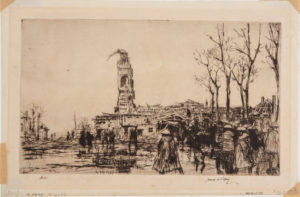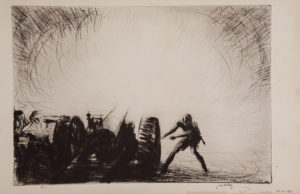WRITTEN BY HEATHER STEWART, MARKETING INTERN

James McBey (British, 1883 – 1959), ‘The Crucifix, Boulogne, 1916’, Etching, Gift of Mrs. James McBey, AG.1961.1.65.
To commemorate the 100th anniversary of American entry into World War I in 1917, the Cummer Museum will be showcasing the works of James McBey from the Permanent Collection in the Millner Gallery beginning on December 17, 2016. The exhibition is entitled Heroes & Battlefields: World War I Prints by James McBey and will be on display through June 20, 2017.
James McBey’s early years were filled with strife. Born on December 23, 1883, in Aberdeenshire, Scotland, he was the illegitimate child of an absentee father and an uncaring mother. He was raised in abject poverty by his mother, whom he called Annie, and his loving grandmother. At 14 he became the family’s breadwinner by landing a job as a bank clerk. For the next 11 years McBey would work his way diligently up the corporate ladder, but escape his responsibilities by reading art books in the library and teaching himself to draw. His passion was clear as he devoured books, learning where and when and from whom he could.
McBey was a dutiful son, and focused on fulfilling his role of caretaker. His mother suffered for years from both psychological and physical ailments, eventually going blind. In his 20s, Annie hanged herself; McBey discovered her body and cut her down.
He wrote later that “it was possible that by leaving as she did she felt she would be making life less difficult for me.”

James McBey (British, 1883 – 1959), ‘Albert, Somme, 1917’, Drypoint, Gift of Mrs. James McBey, AG.1961.1.73.
With no family left, McBey quit the bank and pursued his dream of becoming an artist. He held his first exhibition in London a year later, where his prints were well-received by the art community. He garnered acclaim for the innate skill he showed without much formal training.
McBey enlisted in the military in 1916 at the start of World War I. His poor eyesight prevented him from being a soldier, but he was commissioned as a second lieutenant in the Army Printing & Stationery Service. He continued sketching, creating a series of pictures portraying life on the Western Front. His depiction of the Somme earned him an appointment as an official war artist to the Egyptian Expeditionary Force.
In 1917 he embarked on a new journey that would take him to exotic locales and challenge him both as an artist and as a person. Traveling to Egypt, along the Suez Canal, into the Sinai Desert with the Australian Camel Patrol, and with the Allied advance through Palestine from Gaza to Jerusalem and then to Damascus, McBey etched some of the most influential moments of the campaign. One of his most important contributions was a portrait of Lawrence of Arabia in his final days with the Arabs, as sheikhs knelt before him to say tearful goodbyes.

James McBey (British, 1883 – 1959), ‘Zero. A Sixty-Five Pounder Opening Fire, 1920’, Drypoint, Gift of Mrs. James McBey, AG.1961.1.88.
McBey fell in love with the sun-drenched beauty of Morocco. He would eventually buy a home there with his wife, Marguerite, whom he married in 1930. The couple lived in America for a period of years during World War II, but McBey’s heart remained in North Africa. In 1946 they returned to Tangier where he continued to work until his death in 1959.


